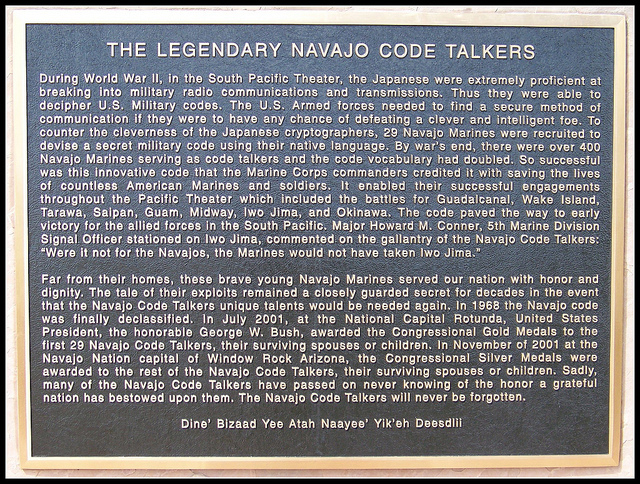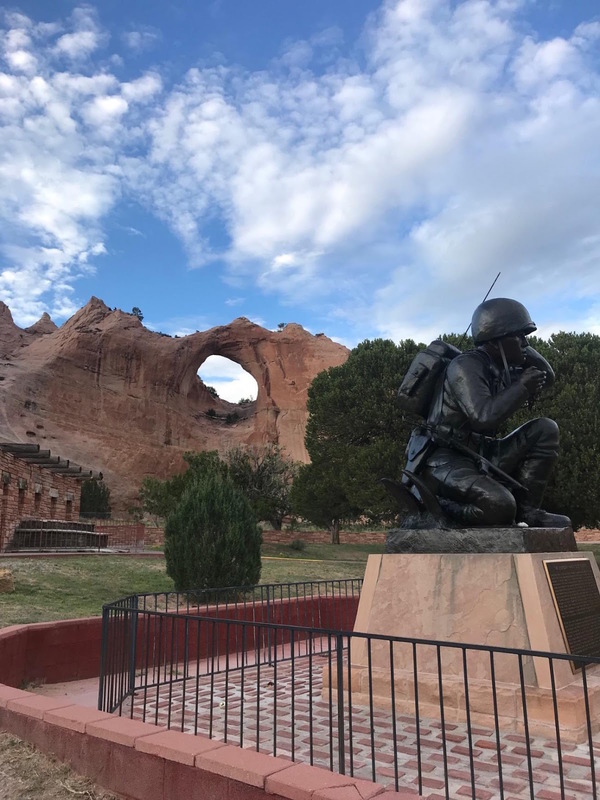Navajo Code Talker Monument

“Navajo Code Talker Memorial.” April 24, 2014. Photo courtesy of John Fowler. https://www.flickr.com/photos/snowpeak/13951197969/in/photolist-nfPx72-2h7DVxk-2eJ1hk6-yR1o5-28H7Nfn-HSCfE6-2a1Gac1-8T8w8i-fuGz4S-fusgTt-xjzZuE-4DjRCw-Le8Lg-QdTzua-PtMeZR-ybiMjr-7BHNp5-rmXPLS-p3ffdQ-aBdK6y-NAc3Kh-ysPzBD-be69Gn-jyF7rZ-8T8wcT-Nq5f4G-FVwsbg-7aGRKn-2dB8Rdr-2dB88Kr-LAr9T-LArdp-cTh7Md-nH4X9d-NVjA6J-4Kcykk-4G1NGk-agZfss-fkBW8R-pMZFQG-4D4XcF-9UpPME-9QxuXq-yR1nX-NGk9rf-gWMdLd-2cvsggt-8a6pnA-n8Hkm6-8zt2xC
Creator: John FowlerThis monument honors the Navajo young men who used their Native language on behalf of the United States of America to transmit coded messages during World War II. Their contributions proved to many the importance and value of preserving native culture.
Early in World War II, the Japanese managed to break every military code transmitted throughout the Pacific Ocean. As a result, U.S. military officials wrestled with the problem of creating an unbreakable code. After the failure of many pilot programs featuring various native tongues, Philip Johnston suggested the Navajo language. Johnston grew up on the Navajo reservation with his missionary family and was one of the few non-Navajos to fluently speak the language. Johnston encouraged the United States Marine Corps to involve the Navajos and supported the development of the Navajo Code Talker program.
The pronunciation and specific use of words in the Navajo language is fundamentally impossible to master as an adult. Many descriptive words sound the same and are only differentiated by an exchange of tone; this aspect of the Navajo language ensured a protected transference and translation of a message to its target. In 1940, fewer than thirty people outside the Navajo tribe knew the language, and the isolation of the Navajo reservation helped preserve its exclusivity.
Prior to World War II and directed by government treaties, many Navajo children attended boarding schools near the reservation, learned English, and were forbidden to use the Navajo language. Although an unplanned benefit, minimizing the use of this native language meant that very few people knew or spoke it, an effect that persuaded the Marine Corps to recruit young Navajos to serve in areas throughout the Pacific Ocean during the war. These young men learned how to use their language as a code for use in combat procedures. As the first 29 Navajo recruits completed bootcamp, they began developing the combat code at Camp Elliot. The unique nature of this descriptive yet ambiguous language made it unbreakable. The Navajo Code Talkers succeeded so well at transmitting and interpreting messages that even U.S. cryptographers could not understand the code, successfully frustrating Japanese translation efforts. The United States accomplished a favorable victory during World War II with the help of the Navajo Code Talkers.
The young men who participated as Navajo Code Talkers honored the Navajo Nation by responding to the need of the United States and completing the required responsibility. The account of their achievements remained secret for decades after World War II due to the government’s confidential policies. In the late 1960s, the United States declassified the topic of the Navajo Code, which allowed Navajo Code Talkers to share their experiences with their families and the nation. In 2010, famous Navajo Ute sculptor Oreland Joe designed and erected the Navajo Code Talker Monument near Window Rock, Arizona. It serves as a tribute to the Navajo Code Talkers who sacrificed and secured victory for the United States.
Images

“Navajo Code Talker Memorial.” April 24, 2014. Photo courtesy of John Fowler. https://www.flickr.com/photos/snowpeak/13951197969/in/photolist-nfPx72-2h7DVxk-2eJ1hk6-yR1o5-28H7Nfn-HSCfE6-2a1Gac1-8T8w8i-fuGz4S-fusgTt-xjzZuE-4DjRCw-Le8Lg-QdTzua-PtMeZR-ybiMjr-7BHNp5-rmXPLS-p3ffdQ-aBdK6y-NAc3Kh-ysPzBD-be69Gn-jyF7rZ-8T8wcT-Nq5f4G-FVwsbg-7aGRKn-2dB8Rdr-2dB88Kr-LAr9T-LArdp-cTh7Md-nH4X9d-NVjA6J-4Kcykk-4G1NGk-agZfss-fkBW8R-pMZFQG-4D4XcF-9UpPME-9QxuXq-yR1nX-NGk9rf-gWMdLd-2cvsggt-8a6pnA-n8Hkm6-8zt2xC
Creator: John Fowler
